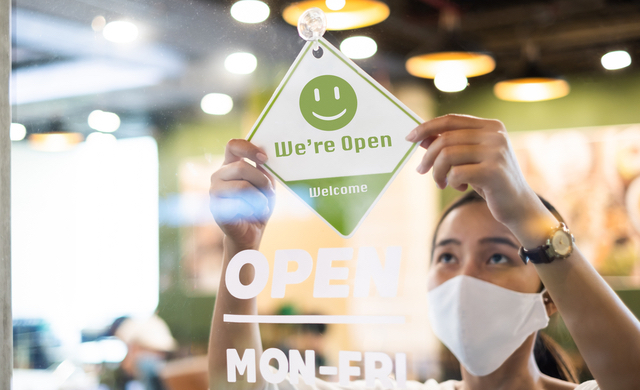
Is it Safe To Eat Outside During Coronavirus? What Health Experts Want You to Know About Dining Out
07/20/2020 06:00AM | 3123 viewsMost people in the US have been without dine-in service at restaurants for weeks (if not months), so it's understandable why many are impatiently waiting for the day they can order their favorite meal again (and not have to eat it on the couch). And as more states begin opening up in various phases, eating establishments across the country are also beginning to open their doors past delivery or takeout.
To help these establishments continue to curb the spread of COVID-19, the Centers for Disease Control and Prevention updated its "Considerations for Restaurants and Bars," providing those places with information on how to protect employees, customers, and communities from the virus during reopening phases. The recommendations include advice on when employees should stay home, information on proper handwashing and hygiene techniques, and the request for all employees and customers to wear face coverings when social distancing isn't possible.
The CDC also ranks restaurant settings from lowest risk to highest risk for possible COVID-19 transmission:
Clearly, it's still your safest option to pick up your favorite meal through a restaurant's drive-through or curbside pickup services, but eating outside during COVID-19 is the next best option—so how safe is it, exactly?
How safe is it to eat outside during COVID-19?
"COVID-19 transmission is less likely to occur in outdoor settings versus indoor settings,” infectious disease expert Amesh A. Adalja, MD, senior scholar at the Johns Hopkins Center for Health Security in Maryland, tells Health. “Breezes in the open air help to whisk away infectious droplets very quickly, and if it’s warm and sunny, the risk of surface transmission would decrease—higher temperatures kill the virus more quickly.”
But that doesn't mean your risk of contracting the virus is zero in an outdoor setting. “If you’re at a table in close contact with potentially infected people, you may be exposed,” Robyn Gershon, MHS, DrPH, a clinical professor of epidemiology at New York University's School of Global Public Health, tells Health.
For starters, people sharing a restaurant table are typically very close to each other—perhaps only inches away. And it’s unlikely that you’d have a face covering on, because you need to be able to eat. Talking can spread the virus (by releasing infectious respiratory droplets), and if you’re sitting together for extended periods of time, this also increases the risk.
It's also nearly impossible to tell who who's carrying the virus—unless they're showing obvious symptoms—and how much of it they can transmit to others. "While we do not yet know the infectious dose of this virus [how much you need to be exposed to in order to actually get infected], there is quite a bit of evidence—outbreaks in choral practices, churches, bars, parties,etc.—that suggests some infected people may be very efficient at spreading it, or even what we refer to as a ‘superspreader,’” Dr. Gershon says.
Past that, you also have to remember that you'll be interacting with others outside of your direct party, like waitstaff, which also ups your risk of infection (though keep in mind COVID-19 has not been found to be spread through food, as its primary way of transmission is through direct contact or contact with highly-touched surfaces).
How can you reduce your risk of catching COVID-19 while eating outside?
To minimize COVID-19 risk when you eat outside, Dr. Gershon advises staying within your “circle of trusted people,” or those you have been staying in close isolation with since lockdown began. “This is not the time to widen that circle of trust unless you are in a very large open area, with plenty of room (six feet or more) between you and others who are not in your circle of trust,” she says.
Also, if you're set on sitting outside at a restaurant, choose one that's onlyoffering outdoor seating right now, since restaurants that offer both indoor and outdoor seating have a higher risk of COVID-19 transmission. You should also try to keep your mask on as much as possible when you're not actively eating.
Fortunately, there are also many things restaurant operators can do to help lower the risk of COVID-19 exposure and spread. The CDC recommends displaying signs in highly visible locations that promote correct handwashing and face covering practices, implementing increased cleaning practices, and requiring all staff to wear face covering whenever possible. Restaurants should also have plenty of soap, hand sanitizer (containing at least 60% alcohol and placed on every table), paper towels, tissue, disinfectant wipes and no-touch/foot trash cans. Disposable options—like paper menus—are also a good idea to reduce the spread of the virus. And while the CDC considerations don’t mention staff temperature checks, Dr. Gershon says these should be carried out on a daily basis, as well as monitoring any symptoms of COVID-19.
If outdoor restaurants follow all recommended health and safety practices, Dr. Gershon believes they’ll be able to operate and keep everybody safe. But there may be some establishments that aren’t taking the pandemic seriously. Some red flags to look out for are tables too close together, tables designed for large groups, and staff without face masks. “Employers should be concerned enough about their employees to want to do everything possible to protect them,” Dr. Gershon says.
And, as usual, it goes without saying that if you or someone in your household has COVID-19, or you feel sick, you should stay home and save your restaurant trip for when you’ve fully recovered. Remember: You're not only socially distancing and wearing masks for yourself, you're doing it for the health and safety of others, too.
The information in this story is accurate as of press time. However, as the situation surrounding COVID-19 continues to evolve, it's possible that some data have changed since publication. While Health is trying to keep our stories as up-to-date as possible, we also encourage readers to stay informed on news and recommendations for their own communities by using the CDC, WHO, and their local public health department as resources.










Post your Comment
Please login or sign up to comment
Comments